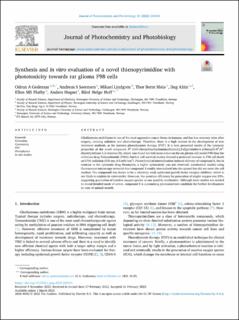| dc.contributor.author | Gederaas, Odrun Arna | |
| dc.contributor.author | Sørensen, Andreas S. | |
| dc.contributor.author | Lindgren, Mikael | |
| dc.contributor.author | Melø, Thor Bernt | |
| dc.contributor.author | Altin, Dag | |
| dc.contributor.author | Flatby, Ellen M. Samdahl | |
| dc.contributor.author | Høgset, Anders | |
| dc.contributor.author | Hoff, Bård Helge | |
| dc.date.accessioned | 2022-09-30T09:33:25Z | |
| dc.date.available | 2022-09-30T09:33:25Z | |
| dc.date.created | 2022-04-20T12:31:48Z | |
| dc.date.issued | 2022 | |
| dc.identifier.citation | Journal of Photochemistry and Photobiology A: Chemistry. 2022, 10 100114-?. | en_US |
| dc.identifier.issn | 1010-6030 | |
| dc.identifier.uri | https://hdl.handle.net/11250/3022809 | |
| dc.description.abstract | Glioblastoma multiforme is one of the most aggressive cancer forms in humans, and has low recovery rates after surgery, ionizing radiation and chemotherapy. Therefore, there is a high interest in the development of new treatment methods, as for instance photodynamic therapy (PDT). It is here presented results of the cytotoxic properties of the novel compound N1-(4-(4-(benzyl(methyl)amino)thieno[2,3-d]pyrimidin-6-yl)benzyl)-N2,N2-dimethylethane-1,2-diamine (1), which was found ten-fold more active on the rat glioma cell model F98 than the reference drug Temozolomide (TMZ). Further cell survival studies showed a profound increase in F98 cell death on UVA-radiation (330 nm, 0.5 mW/cm2). Photochemical internalization induced delivery of compound 1, but in contrast to the cytostatic drug Bleomycin, a higher cytotoxicity was not observed. Localization studies using fluorescence microscopy revealed that compound 1 readily internalized into the cytosol but did not enter the cell nucleus. The compound was shown to be a relatively weak epidermal growth factor receptor inhibitor, which is not likely to explain its cytotoxicity. However, the quantum efficiency for generation of singlet oxygen was 23%, suggesting generation of reactive oxygen species as one possible mechanism. Although more studies are needed to reveal detailed mode of action, compound 1 is a promising photosensitizer candidate for further development in tests of animal models. | en_US |
| dc.language.iso | eng | en_US |
| dc.publisher | Elsevier | en_US |
| dc.rights | Navngivelse 4.0 Internasjonal | * |
| dc.rights.uri | http://creativecommons.org/licenses/by/4.0/deed.no | * |
| dc.title | Synthesis and in vitro evaluation of a novel thienopyrimidine with phototoxicity towards rat glioma F98 cells | en_US |
| dc.title.alternative | Synthesis and in vitro evaluation of a novel thienopyrimidine with phototoxicity towards rat glioma F98 cells | en_US |
| dc.type | Peer reviewed | en_US |
| dc.type | Journal article | en_US |
| dc.description.version | publishedVersion | en_US |
| dc.source.pagenumber | 100114-? | en_US |
| dc.source.volume | 10 | en_US |
| dc.source.journal | Journal of Photochemistry and Photobiology A: Chemistry | en_US |
| dc.identifier.doi | https://doi.org/10.1016/j.jpap.2022.100114 | |
| dc.identifier.cristin | 2017858 | |
| cristin.ispublished | true | |
| cristin.fulltext | original | |
| cristin.qualitycode | 1 | |

